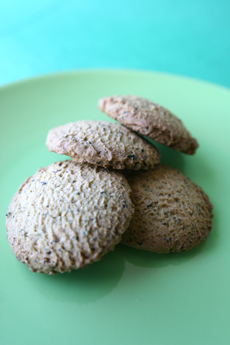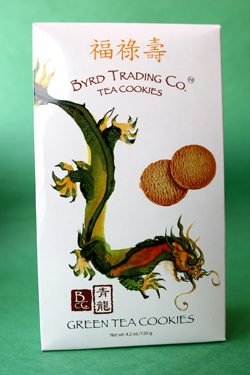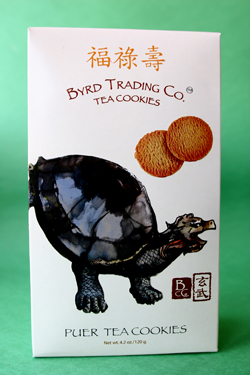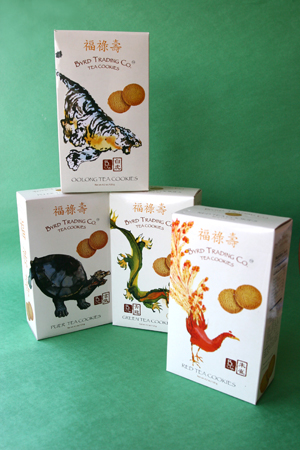

Green Tea Cookies have lots of green tea in the batter. Can you drink them with green tea? Certainly!
|
KAREN HOCHMAN is Editorial Director of THE NIBBLE™.
|
|
May 2007
|
 |
Byrd’s Tea Cookies
Unusual Cookies Made With Tea: Green, Oolong, Red & Puer
CAPSULE REPORT: These “tea cookies” are no simple biscuits to be served on a platter at tea time. They’re exotic fusion cookies that combine fine teas with a Western recipe. The result is something completely different: delicate cookies flavored with fine teas—green, oolong, puer and red, an exotic taste of the Orient.
You most likely have never tasted anything like the tea cookies from Byrd Cookie Company, which are made in China to the company’s specifications. We have combed the many bakeries of New York City’s Chinatown and not found tea leaves baked into cookies. There is a sense of familiarity, because Chinese cookies, no matter what type or flavor, tend to downplay the sugar. That’s what Byrd’s Tea Cookies are like: very lightly sweetened—similar to wheatmeal biscuits—allowing the tea flavor to shine through.
Varieties
The recipe has the foundation of a butter cookie, but you won’t taste the butter: The tea flavor dominates. While the ingredients cite “tea powder” and “tea essence,” this is no finely-ground matcha*: As you can see in the photo at the left, large flecks of tea inhabit the entire cookie. Eating tea leaf† is a different experience from drinking an infusion of it in water: The flavor is of a sweet herb‡, a bit floral.
| |
*Matcha is a fine green tea powder used in Japanese tea ceremony and to flavor and color foods such as green tea ice cream, soba noodles and a desserts such as mochi and wagashi.
†You can eat whole tea leaves: Green are the best, and are very tasty on yogurt and sprinkled in salads. Use them as you would any herb to add flavor accents. We like them on fruit salads and as a garnish on stewed fruits, too.
‡While not technically an herb, which is a plant lacking a permanent woody stem, the tea leaf is used in the manner of both a culinary and a medicinal herb. |
All real tea comes from Camellia sinensis, the botanical name for the tea plant, which grows as a shrub or a tree depending on the region. An evergreen, it is a member of the same family as the camellia flower. The many different types of dried tea available for drinking stem from how the tea is processed after the leaves are picked. (Read more about the different types of tea.)
The cookies are made with four of the six categories of tea. Missing are white tea, which is very delicate in flavor, and black tea, the most oxidized, which is similar enough to oolong for the purpose of cookie-baking. Red tea represents the herbal tea category, which is not real tea (i.e., not Camellia sinensis) but an infusion of berries or other fruits, herbs, roots or flowers, all caffeine-free.
- Green Tea Cookies (Dragon Box): Green tea is the natural dried leaf that is not oxidized (fermented).
- Oolong Tea Cookies (Tiger Box): Oolong is semi-oxidized tea that falls between green and black tea on the fermentation continuum. Green tea does not ferment at all, back tea ferments for two to four hours; with oolong, the fermentation process is interrupted in the middle, about one hour.
- Puer Tea Cookies (Turtle Box): Considered a medicinal tea in China, it is credited with reducing cholesterol, curing hangovers and other problems. This is also the tea sold as “Slimming Tea” and “Beauty Tea.”
|

Green Tea Cookies. |
- Red Tea Cookies (Peacock Box): Red tea, formally known as rooibos (pronounced ROY-boss), is an herbal tea from the leaf of the African rooibos bush. It is called red tea or red bush tea because of the red color of the liquor (brew).
We really like these cookies, but the concept doesn’t go far enough. Let us explain, and offer a solution.
The four teas, which are extremely different when brewed, have a similarity of flavor when mixed dry into dough and baked. The four cookie varieties not only look the same (making it tough to put more than one variety on the same plate), but it would take a palate as acute as wine writer Robert Parker’s to distinguish one variety from the other by taste.
The solution would be to add a second ingredient to three of the four varieties—keeping the Green Tea Cookie as is, for example, and adding flavor variety and visual distinctiveness to the others. For example, one could keep the tea theme and the Chinese flavor profile by adding almonds to the Oolong Tea Cookie, toasted sesame seeds to Puer, and dried lychee or another fruit to Red.

Puer Cookies: Turtle cookies? Stronger food
imagery on the boxes might have more
palate appeal.
|
We’d also replace the photos of the cookies on the box—which don’t show the tea—with more realistic ones. Anecdotally, the beautiful embossed artwork that was commissioned from a Chinese artist may not sell the product as well as it could. Consumers are very visual: a photo of a cookie bursting with chocolate chips will sell better than a plain box labeled “World’s Best Chocolate Chip Cookie.” People see pictures before they see words.
Along this line, we gave the Puer Tea Cookies (shown in the photo at left) to our physician, who is of Chinese descent, and handed him the box saying that we had just reviewed this very interesting line of cookies imported from China. “Turtle cookies?” he asked.
Point confirmed. There’s a reason that specialty food packaging has delicious food photos. We’re not trying to tell the manufacturer how to market the product; however, we want someone to be excited when we bring them a gift.
|
Serving Suggestions
When you’d like to enjoy something distinctively different—and introduce your guests to interesting new flavors—you don’t have to wait to serve Asian food. Serve these cookies:
- With any kind of tea or iced tea (there’s no need to match the flavor of the cookie to the type of tea)
- With soft cheeses, e.g. triple-crèmes, brie and goat cheese
- On a dessert or cookie plate
- With vanilla or Japanese ice cream flavors (green tea, red bean, ginger—look for Asian brands in international supermarkets or Ciao Bella’s Green Tea with White Chocolate ice cream, one of our favorite flavors)
- As a dessert option for people who don’t generally like sweets
- With a glass of sherry or Port after dinner
We will admit: These cookies were a controversial item with THE NIBBLE tasting panel. Although all tasters enjoyed Asian cuisine (and two were of Chinese ancestry), the majority of palates were not attuned to the non-traditional flavor of tea baked into cookies. Perhaps the name led them to think of a traditional “tea cookie”—something with notes of butter, vanilla and sugar. It seems that as a final product change, we need to come up with a better name for this product so people can appreciate it for what it is. We’re stuck on “tea biscuit.” If you come up with something better, please let us know.
The 1-3/4" cookies are individually packaged, a dozen per box, so they’ll stay fresh for a long time.
BYRD COOKIe company
Tea Cookies In Green, Oolong, Puer and Red
- Set Of 4 Boxes
One Of Each Flavor
4.2 Ounces/12 Cookies Per
Box
$19.95
Purchase online at ByrdCookieCompany.com
(Currently on Page 4 of Everyday Gifts)
Or telephone 1.800.291.2973
Shipping additional. Prices and flavor availability are verified at publication but are subject to change. |

|

|







